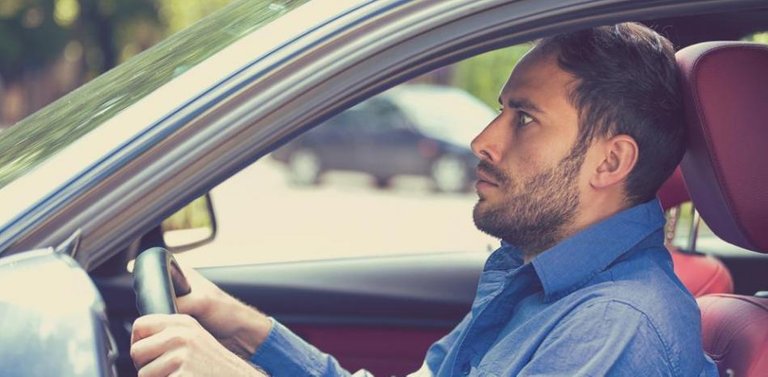The fear of driving is a relatively common phenomenon in all types of people of age to drive these vehicles, and it is not in itself something that should be a problem in all cases. Sometimes nothing happens to suffer this type of discomfort simply because you have neither the desire nor the need to drive, and it may also happen that this fear is easy to overcome in a matter of hours or a few days, and that it does not hinder driving.

Now, there are cases in which the anxiety caused by driving leads to many problems, to the point where it is a factor that damages the quality of life of the person.
In these cases we speak of amaxophobia, or phobia of driving. But ... how to recognize the boundary that separates the simply unpleasant or uncomfortable, on the one hand, and the pathological, on the other?
The keys to recognizing a driving phobia
It is estimated that around 20% of drivers suffer to a greater or lesser extent a certain level of anxiety when driving. However, in most cases we cannot speak of a phobia. To a certain extent it is to be expected: the high speeds that we experience while driving one of these vehicles, combined with the awareness that in a few seconds we could cause moral accidents, can be interpreted as a source of constant danger.
And after all, natural evolution has not been shaping our brains so that we are very good at moving so fast; We need months of practice just to start doing it without serious danger, and even with a license, accidents are frequent (very rarely we will see birds colliding with natural elements of their environment when flying, for example).
Normally, we reach a point where we learn to handle ourselves well with the car, motorcycle or whatever vehicle. But just as we can learn to stop being afraid of driving, we can also learn to earn it (unintentionally, of course). And sometimes, this fear is so intense that it stops being fear and becomes a psychopathology.
Thus, phobias are a mixture of biological predispositions (the fact that we can experience anxiety allows us to react in time to dangers) and learning (we can associate any emotion with any stimulus).
Now, it is not always easy to understand well what type of emotions we are experiencing, and whether what happens to us is a psychological disorder or not. Although the diagnoses are ultimately made by mental health professionals, it is important to know some keys to detect signs and symptoms of psychopathologies. And in the case of driving phobia, the key ideas that help us to know if we are suffering from it or not are the following (it is not necessary that they all occur in the same person).
1. When driving or trying, we feel that we lose control over the body
The feeling of loss of control over oneself is typical in phobias of all kinds. Tremors and respiratory agitation also appear.
2. The very idea of driving produces anxiety
Wherever there is a phobia of driving, the act of closing our eyes and imagining that we are driving causes our anxiety levels to rise significantly.
3. We look for excuses not to drive
Those who do not drive for economic, ecological or logistical reasons (for example, lack of parking) do not look for excuses not to choose the car and the motorcycle as a means of transport. But those who suffer from driving phobia are inclined towards lying or hiding their main motive.
4. Catastrophic thoughts appear when driving or going to drive
As in all phobias, the phobic stimulus causes pessimistic forecasts to emerge about what will happen in the next few minutes.
5. We are concerned that in emergencies we will be forced to drive
Those who suffer from driving phobia also experience, from time to time, anxiety at the idea of circumstances in which they must drive because of an emergency or because of something that a family member or friend needs.
Article Referenced:
- https://www.psychological-consulting.com
- Barp, M. & Mahl, AC (2013). Amaxophobia: a study on the causes of fear of driving. UNOESC and Science - ACBS, 4: pp. 39 - 48.
- Clapp, J.D.; et al. (2011). The Driving Behavior Survey: Scale construction and validation. Journal of Anxiety Disorders, 25(1): pp. 96 - 105.
- Hickling, E.J.; Blanchard, E.B. (1992). Post-traumatic stress disorder and motor vehicle accidents. Journal of Anxiety Disorders. 6 (3): pp. 285 - 291.
- Sáiz Vicente, E., Bañuls Egeda, R. and Monteagudo Soto, MJ (1997). Exploring anxiety in novice and professional drivers. Annals of Psychology, 13 (1): pp. 65 - 75.
- Taylor, Joanne; Deane, Frank; Podd, John (June 2002). "Driving-related Fear: A Review". Clinical Psychology Review. 22(5): pp. 631 - 645.
Congratulations @psicologiaexpres! You have completed the following achievement on the Hive blockchain and have been rewarded with new badge(s) :
You can view your badges on your board and compare yourself to others in the Ranking
If you no longer want to receive notifications, reply to this comment with the word
STOPDo not miss the last post from @hivebuzz:
Personally I love driving but do get paranoid when others are driving.
Dear @spaminator
Would you be kind to tell me why was this post downvoted? Was there any particular reason?
Just curious,
Yours, Piotr